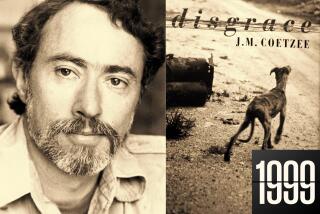The Education of Carolyn Forche : Writer Recalls Harrowing Experiences in Third World
“I’m very grateful to the people who took time to educate me,” poet Carolyn Forche was saying. “The people in South Africa, Lebanon and El Salvador.”
It was a weekday afternoon, and Forche was sitting in a pretty apartment on a quiet, tree-lined street near UCLA. The apartment, furnished in designer grays and pinks, is modern, impersonal. It comes with maid service, and while Forche talked, a middle-aged Latina washed dishes in the kitchen.
It’s an ironic kind of life style for Forche, whose best-selling book, “The Country Between Us,” described the horrors of life in El Salvador. Indeed, the 36-year-old writer said: “It’s very difficult for us to be here.”
Forche, who was a visiting poet at UCLA last winter, had been out of the country nearly two years, living in France and South Africa with her husband, Harry Mattison, a photographer for Time magazine who has also covered the wars in Lebanon and Central America. Although she has written only two books of poetry, she is probably one of the best-known young American poets, in part because her work is driven by her concern for the forgotten and oppressed.
“Gathering the Tribes,” which won the 1975 Yale Series of Younger Poets award, described her Czechoslovak ancestors, her childhood in rural Michigan, her travels among the Indians of the Southwest. “The Country Between Us” was populated with political dissidents, Holocaust victims, murdered Salvadorans.
Such is Forche’s reputation that at the Los Angeles Theatre Center a few weeks before, a full house turned out to hear her read her poetry. Toward the end of the evening, she spoke urgently of her visit to South Africa last year. It was, she said forcefully, “the most evil and ignoble place” she had known. “There are things impossible to imagine,” she went on, “and they are also the most difficult to write about when they are seen.”
The eldest of seven children, Forche grew up in a rural area near Detroit, the daughter of a factory worker and the granddaughter of Czechoslovak immigrants. Encouraged by her mother, who had written poetry as a young woman, she began writing poetry as a child.
Although she knew she wanted to write, “I did not know one could be a poet or writer. I felt that I had to support my writing. So I spent my childhood determined to become a physician.”
At Michigan State University she ended up taking classes in language, creative writing and history, graduating with a degree in international relations. “Ironically, I studied everything I would need for the later work that I would do.”
After working as a legislative analyst in Washington for part of a year, Forche enrolled at Bowling Green State in Ohio, thinking that a master’s degree would help her land a better job in Washington. But in 1975 she took a teaching job at San Diego State, a decision that dramatically shaped her life.
Salvadoran Poet
“I befriended there a young woman named Maya Flakoll,” Forche said. “Maya’s mother was the Salvadoran poet Claribel Alegria. She was living in Spain, and I subsequently went there to translate her work.”
In 1978 Forche received a Guggenheim grant for poetry. She thought of going to Paris, but when friends of Alegria’s suggested that she visit El Salvador, she went there instead. As Forche explained: “I felt terribly ignorant of the Third World. I felt I needed to know the culture, the living conditions, in order to do a good job as a translator. I would not have been brave enough had I known what was going to happen.”
Forche spent two years in El Salvador, working as a journalist and reporting on human rights violations for Amnesty International. In 1981, “The Country Between Us,” in part a harrowing account of her experiences there, was published, and was an immediate critical success.
One prose poem in particular, “The Colonel,” was quoted repeatedly in reviews. Terse and brittle, it was evidence not simply of Forche’s gift for language but of the prevailing mood of terror in El Salvador.
‘For Your Poetry, No?’
In the poem she described dining at the home of a Salvadoran military officer one evening. They had drunk wine, dined on rack of lamb, when he abruptly left the table. “The colonel returned with a sack used to bring groceries home,” she wrote metaphorically. “He spilled many human ears on the table. They were like dried peach halves. . . . ‘Something for your poetry, no?’ he said.”
Though her book gave meaning to a troubled country Americans were barely aware of then, Forche found little joy in her success. “It was shortly after the nuns were killed (the four American churchwomen who were murdered in December of 1980) that my book came out,” she recalled. “The war had greatly intensified. So it was an intensely sad experience for me.”
El Salvador was a place that marked Forche in other ways. Outraged by what she saw, she became an outspoken critic of U.S. involvement in El Salvador, lecturing extensively in this country on the situation there. As she explained: “It changed my consciousness. My obsessions changed. I became deeply concerned with human rights, with hunger and homelessness. When I came back from Salvador, there were very few people willing and able to talk about it. I felt an obligation.”
It was in El Salvador that she also met Mattison, then a free-lance photojournalist who later won the distinguished Robert Capra Prize for his El Salvador work. Their son Sean was born last summer.
A Shared Commitment
In a way they are an unlikely couple. He is a large man with an outgoing manner and hearty laugh. She is a small, reserved woman who speaks softly and rarely smiles. Dressed in a plain black sweater and skirt, her light brown hair cut blunt to her shoulders, she looks like a prim Catholic schoolgirl.
But it is immediately apparent what they do share: a passionate commitment to recording the human cost of political injustice. “El Salvador: The Work of 30 Photographers,” a book of images documenting that country’s nightmare, was written by Forche and contained many of Mattison’s photographs.
And on this particular afternoon, as she talked of El Salvador and South Africa, Mattison frequently entered the living room to listen and express his own views.
Asked about the difference between the two countries, Forche said, “Well, in Salvador the people were able to organize, they were able to fight back. Right, Harry, is that it?”
“That’s right. The people did have the right to fight back.”
“In South Africa, the government has one of the most extensive security apparatus”--Forche paused--”it’s a security machine. They’ve infiltrated the entire country. It’s very scientific.”
Forche and Mattison lived in a white suburb of Johannesburg, in a home they shared with a black woman from Swaziland. Such was the blatant nature of government surveillance, Forche recalled, that she could hear the person bugging their telephone. On another occasion, she said, she received a letter that had been torn open and clumsily resealed.
“It was just massively depressing for us. In El Salvador, you might feel unnerved and edgy because you know there are death squads and they might be watching you, but in South Africa you know for sure you’re being watched.”
However, what they wanted to discuss about South Africa, and repeatedly emphasized, was what Forche called the “enormous good will” among blacks toward whites.
One day they were driving through an area, Forche said, where 20,000 mine workers had recently been fired for agitating for a labor union, when they saw three black mine workers walking along the road. They stopped to give them a lift. “They were walking home, which was a long way, and were very taken aback at the idea of climbing into a white person’s car until they discovered we weren’t South Africans.” Toward the end of the drive, one of the men made them a bold proposition: “If you really want to understand South Africa,” he told them, “you must visit the rural villages. If you like, I will take you to my village.”
Taking Chances
At his village, a “sprawling camp” in the black homeland of Bophuthatswana where people had been placed by the government, they met the miner’s mother. She lived in a shack with no plumbing or electricity. The miner, who worked 15 to 16 hours a day and earned $47 a week, gave his mother half his salary, on which she was supporting 16 children. Some were hers, but most belonged to people who had died.
“So this young man,” Forche said, “took two strange white people that he didn’t know into a village. He had to vouch for us to make sure that any hostility that might have been there toward white people would not be directed at us. He had to take his chances with the authorities because obviously they have the power to do anything to him that they want. He was interested in educating us and willing to take those chances.”
To the casual visitor to South Africa, Forche said, the country revealed is a tropical paradise. “You could see palm trees and beautiful beaches and stay at the Hilton. One of the unnerving things about being in South Africa is how much you are reminded of your own country. Because of apartheid, you expect to see a country that is very different. But it looks like Southern California.
“I knew journalists who refused to change their standard of living,” she said. “They would have a little apartment in New York City, and in South Africa they could afford a very large house, a servant, a pool, a BMW.”
Forche and Mattison went to South Africa hoping to learn the truth, a commodity that proved elusive.
“We originally thought we would make a document with text and photographs of what we had seen in South Africa. But opportunities for the media to be in South Africa narrowed, and we did not want to return there after the birth of our son.”
Forche kept a journal when she was in South Africa, and though she hopes to write about what she saw, she expressed some doubt. “I’m not sure it’s possible in a sense to communicate the horror of South Africa because there’s very little context for it.”
More to Read
Sign up for our Book Club newsletter
Get the latest news, events and more from the Los Angeles Times Book Club, and help us get L.A. reading and talking.
You may occasionally receive promotional content from the Los Angeles Times.









